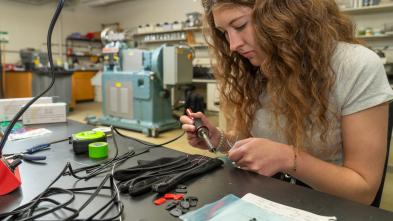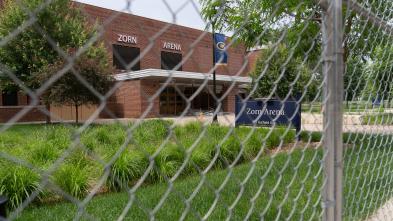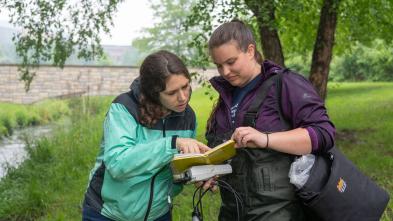
Pivot for a pandemic: Geography field studies 2020-21
Field study seminar courses are a program highlight for University of Wisconsin-Eau Claire geography majors, typically taking Blugolds to far-off locations to examine the intersections among natural resources, diverse cultures, unique landscapes and urban centers.
When the COVID-19 pandemic brought all such travel experiences to a screeching halt, UW-Eau Claire faculty were left with only one choice — reimagine locally based field studies and find ways to accomplish the same goals.
The intersections that brought to life for students the vital connections between history, people and place — a core guidepost of geographical studies — would have to be achieved closer to home.
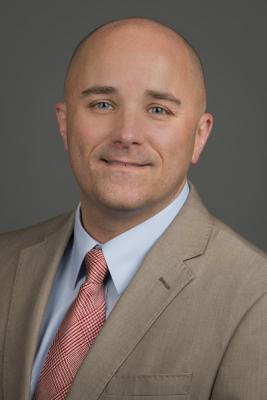
Dr. Ezra Zeitler, professor and chair of the geography and anthropology department, was saddened by the need to cancel travel in 2020-21, but he now sees some silver linings to the entire experience, for students and faculty alike.
“One of the realizations that came from being forced to look locally for course development is an appreciation for the assets that are right here — the cultural assets, the financial and personal investments that people have been making in support of their passions,” Zeitler says.
“Whether it was an individual running a cranberry bog or a dairy farm in the region hiring Latinx workers, or operating a locally sourced pizza barn in Athens, Wisconsin, students were able to witness those passions and how they help careers and communities intersect.”
Examining the big picture on a local scale
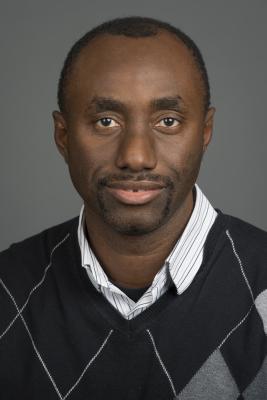
Dr. Cyril Wilson, associate professor of geography and anthropology
Fall 2020 Geography Field Seminar students with Dr. Cyril Wilson at Willow River State Park in St. Croix County.
Dr. Cyril Wilson’s fall 2020 Geography 368-Field Seminar class originally was set to explore the geography of southern Arizona and would have focused on human-environment interactions — a theme that likely would have strongly resonated with students given the extreme drought in the region.
Instead, the students toured a total of 24 regional sites in Wisconsin and Minnesota, including:
- Dairy farms.
- River Bend vineyard and winery in Chippewa Falls.
- Wildlife refuges in Trempealeau and Wabasha, Minnesota.
- Geographical features like the Chippewa Moraine Ice Age Trail, the Blue Hills Felsenmeer in Rusk County and Levis Mound Trail Center in Neillsville.
- Food production facilities like Marieke Gouda in Thorp and Jennie-O Turkey in Barron.
- The Ho-Chunk Nation reservation and administration center in Black River Falls.
- The Itaqwa Masjid Islamic Center in Barron.
- Cranberry bogs in Warrens.
- State parks.
“I adopted a place-based analysis of west-central Wisconsin that encapsulated all the major subfields of geography — physical, human-environment, economic and cultural geography,” says Wilson, an associate professor of geography and anthropology. “The pool of potential themes for this local version was broader because west-central Wisconsin is more geographically diverse than southern Arizona.”
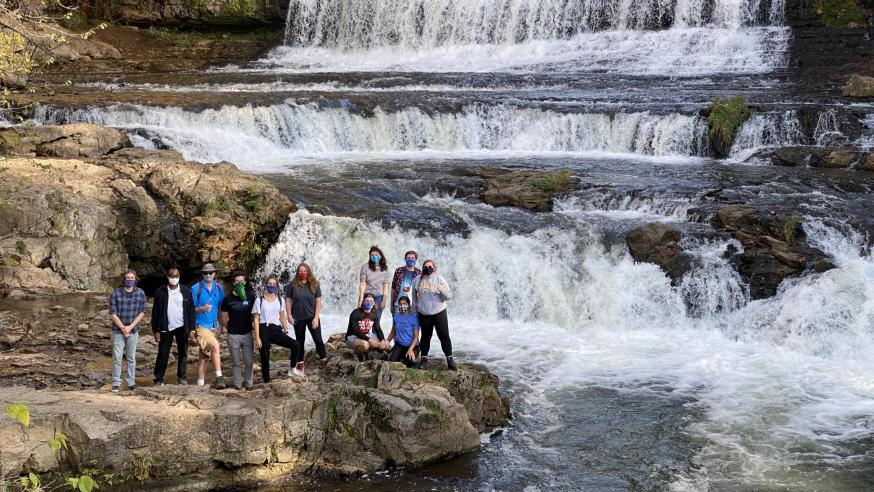
Wilson says that these broad themes offered an overall advantage in the course as each geography student has diverse strengths across the various approaches in studying geography, strengths that he says came into play while writing term projects to complete the course.
“Students were able to visualize previously familiar sites within a different lens,” Wilson says. “For instance, several students had visited the Chippewa Moraine prior to the course but were able to learn more about the moraine through the eyes of a geographer.”
Then-senior Aaron Dekker, who graduated in May 2021, was happily surprised by the discoveries class members made in their “own backyard.”
“Western Wisconsin is way more diverse, in terms of culture and topology, than I thought,” the Whitehall native says. “I’d driven past some of these places many times growing up in this region, and the field trip proved that there is much more to our neighborhoods than we think.”
Tressa Lange, a May 2021 graduate with degrees in environmental geography and American Indian studies, found the visit to the Ho-Chunk Nation to be a useful supplement to the courses she had in the AIS major.
“I learned a lot about the Ho-Chunk that I did not know before,” Lange says. “While visiting this site we were able to learn a lot about their culture and how they view the environment — to me that was extremely interesting.”
Spring 2021 Field Study: The Geography of Community
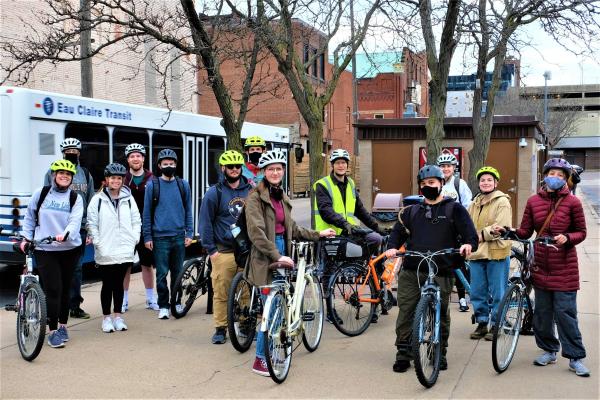
The spring 2020 Geography Field Study course, which was canceled entirely, originally was planned as a 10-day trip that would have taken students to Hawaii with Dr. Doug Faulkner, professor of geography. For the spring 2021 course, Dr. Paul Kaldjian, professor of geography, reimagined both the course content and the travel mode to accommodate COVID-19 restrictions.
As described in the course website, The Geography of Community was a locally based field seminar examining the concept of community from “a wide range of disciplinary perspectives: sociology, psychology, geography, political science, urban affairs, planning, law, architecture, health, sustainability and tourism, among numerous others.”
Kaldjian described bicycle travel throughout the Eau Claire area as a unique and enjoyable element not before incorporated in the Geography 368 courses.
“We conducted all of our field travel by bicycle,” Kaldjian wrote. “For some students, this meant refreshing skills neglected since middle or high school. For all of us, it meant active participation in our own mobility and new encounters with the community we were studying. Traveling in a pack of 15 people was a new and exciting experience for many students.”
The seminar was set up to seek and examine the connections between the people and places of the Eau Claire community, and the projects created by the field seminar students spanned a wide range of topics and methodologies, including the following:
- Community as it relates to neighborhoods, architecture, green spaces, third spaces (not home or workplace) and senior spaces.
- Communities reflected in aspects like running, use of transportation, handicapped accessibility, farmers markets, religious amenities, and dog-friendliness and facilities.
- The role of the internet and virtual networks in the community.
Senior geography and economics double major Nathan Walker found the exploration of community through geography in the spring field study to be a perfect match for his majors. He was grateful for the unique opportunity to closely examine the community he has lived in as a student for four years.
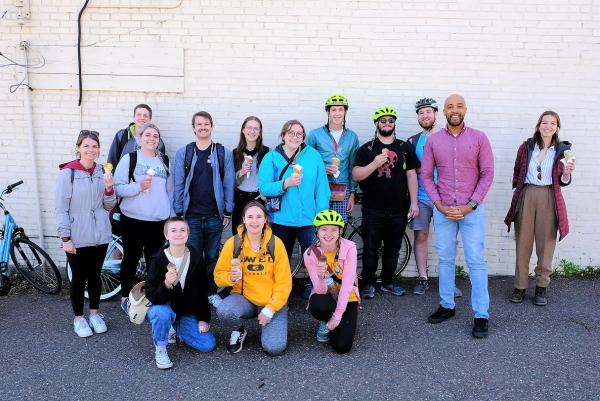
Spring 2021 Geography Field Seminar students ran into Lt. Gov. Mandela Barnes (second from right) while on an ice cream break during fieldwork in Eau Claire.
“As a student, it is often easy to forget just how much is happening off campus,” says the Germantown native. “This class took me to a variety of fascinating locations and introduced me to many community leaders. The change to a local focus in GEOG 368 really exemplifies one of the main concepts of geography — space is everywhere to be studied, even in your own hometown.”
Walker also noted that the way this field studies course was developed helped to facilitate community among the participants while examining the ones around them.
“The teamwork aspect of the class was huge as well. Our geography department at UWEC excels in forming a community of its students and faculty, and this class was no different. We had strong discussions, collaborative efforts, independent work and passions that many graduate school professors aspire to build.”
Looking ahead to the next field studies with fresh eyes
As one of the core requirements of all geography majors, the field study courses have long been one of the most highly anticipated and fondly reviewed experiences of Blugold geography graduates. What the department leadership, faculty and students achieved with these cornerstone classes of the 2020-21 academic year was emblematic of the global pandemic experience throughout education.
There have been many unanticipated “gifts” in these locally focused seminars, hidden gems of the city and regional communities that can now be added to curriculum and syllabi in other ways.
Wilson says that his students found the courses far exceeded their “COVID expectations” and with the general stress of the pandemic still looming, the luxury of “returning home to their own beds each night after a long day of fieldwork” was a much-appreciated bonus.
“These courses had a significant impact on the students,” Zeitler says. “They revealed unknown or underappreciated connections between the place where we live and the people that make it hum. These courses helped earn internships and jobs, and preparation for graduate school. That’s a great outcome.”
For more detail about the two Geography 368 Field Study courses, visit the West Central Wisconsin Field Seminar website and the Geography of Community website for full course descriptions and project details.
You may also like
